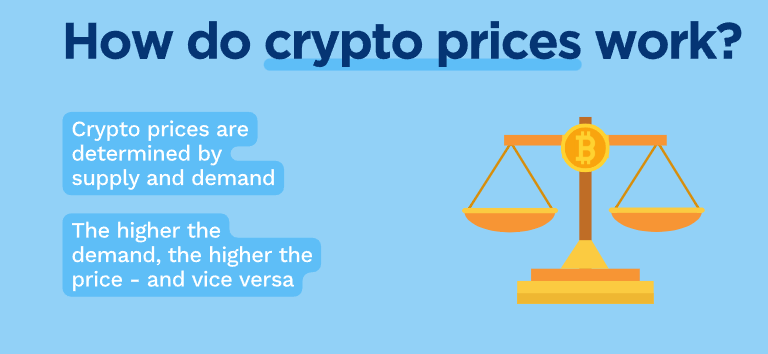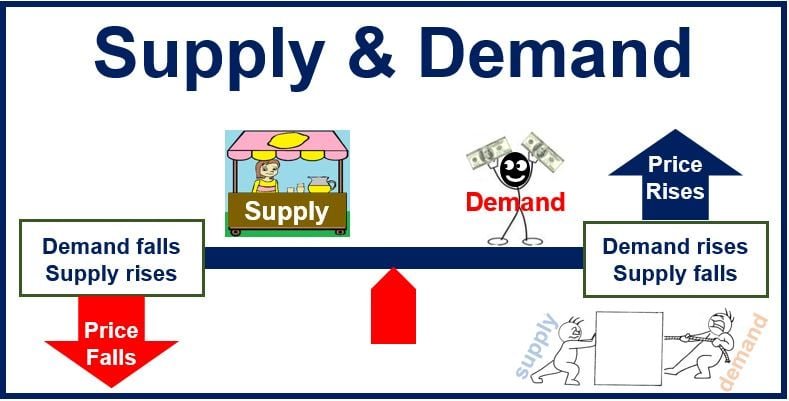Cryptocurrency prices can feel like a wild ride—one day Bitcoin soars, the next it dips. For new investors, understanding what makes these prices move is crucial to making smart choices. From news headlines to market hype, many factors shape crypto’s ups and downs. This beginner-friendly guide explains what drives crypto prices in 2025, using simple terms, and offers tips to invest wisely without getting lost in the noise.

Why Are Crypto Prices So Volatile?
Crypto prices swing more than stocks or gold because the market is smaller ($2 trillion in 2025) and less regulated. A single tweet or law can spark a 20% jump or crash. Understanding the key drivers helps you navigate this volatility.
Key Idea: Crypto prices are driven by supply, demand, and human behavior, not just technology.
Why It Matters: Knowing these factors can help you avoid buying at peaks or selling in panic.
Key Factors Driving Crypto Prices
Here’s what moves crypto prices in 2025, explained for beginners.
1. Supply and Demand
Like any market, crypto prices depend on how many coins are available (supply) and how many people want them (demand).
Supply: Most cryptos, like Bitcoin, have a fixed or limited supply. Bitcoin’s cap is 21 million coins, making it scarce over time.
Demand: More buyers (e.g., due to hype or adoption) push prices up; fewer buyers cause dips.
Example: Bitcoin’s 2024 halving cut mining rewards to 3.125 coins per block, reducing supply and boosting prices in 2025.
Tip: Check supply details on CoinGecko.

2. Market Sentiment and Hype
Investor emotions—fear, greed, or excitement—drive prices, often amplified by social media like X.
How It Works: Positive news (e.g., a celebrity buying NFTs) sparks FOMO (fear of missing out), raising prices. Negative news (e.g., a hack) triggers fear, causing sell-offs.
Example: In 2021, Elon Musk’s X posts about Dogecoin caused a 10,000% price surge, followed by a crash.
Tip: Monitor sentiment with the Fear & Greed Index on Alternative.me.
3. News and Events
Big news, like regulations, partnerships, or tech upgrades, can swing prices overnight.
Examples:
- Regulations: A 2024 U.S. crypto tax law caused a 10% Bitcoin dip.
- Adoption: PayPal’s crypto payment support in 2023 lifted prices.
- Upgrades: Ethereum’s 2025 scalability update could boost its price.
How to Stay Updated: Follow Cointelegraph for reliable crypto news.

4. Institutional Investment
Big players like hedge funds and companies (e.g., Tesla) buying crypto can drive prices higher.
How It Works: When firms invest billions, demand spikes, pushing prices up. Their sell-offs can crash markets.
Example: Bitcoin ETFs, launched in 2024, brought billions in institutional money, lifting Bitcoin past $100,000 in 2025.
Tip: Track institutional moves on CoinDesk.
5. Technology and Development
A crypto’s tech and updates affect its value. Stronger tech or new features can attract investors.
Examples:
- Ethereum’s 2022 switch to energy-efficient staking boosted its price.
- Solana’s fast, low-cost blockchain drew DeFi users, raising its value.
How to Track: Check project roadmaps on their official sites or CoinGecko.
Example: A 2025 Ethereum upgrade for faster transactions could spark a rally.
6. Market Manipulation
Whales (investors with large holdings) or coordinated groups can manipulate prices, especially in smaller coins.
How It Works: “Pump-and-dump” schemes hype a coin on X, inflating prices, then sell off, crashing it.
Example: In 2024, a hyped NFT token surged 500% in days, then crashed 90% when whales sold.
Tip: Avoid low-volume coins and check trading history on CoinGecko.

7. Global Economic Factors
Inflation, interest rates, and economic crises influence crypto as investors seek alternatives to cash.
How It Works: High inflation (e.g., 7% in 2024) drives investors to Bitcoin as a “digital gold” hedge.
Example: During 2022’s stock market dip, Bitcoin held steady, attracting risk-averse investors.
Tip: Watch economic news on Cointelegraph for context.
How to Use Price Drivers to Invest Smarter
Knowing what moves prices helps you invest with confidence. Here’s how to apply this knowledge in 2025.
1. Practice Dollar-Cost Averaging (DCA)
DCA means buying a fixed amount regularly, smoothing out volatility’s impact.
How to Do It:
- Invest $10 weekly in Bitcoin on Coinbase.
- Buy more during dips, less during peaks.
- Focus on long-term growth, not short-term swings.
Example: DCA reduces losses if Bitcoin drops 20% after a news event.
2. Diversify Your Portfolio
Spread risk across assets to protect against price crashes in one coin.
How to Do It:
- Invest 60% in Bitcoin, 20% in Ethereum, 20% in stablecoins like USDC.
- Try a $5 NFT on OpenSea for exposure to trends.
- Keep crypto at 5–10% of your total investments.
Example: If an altcoin crashes 80%, Bitcoin and USDC cushion the blow.

3. Stay Calm During Volatility
Price swings from hype or news can tempt emotional trades. Stay disciplined.
How to Do It:
- Set a plan (e.g., hold Ethereum for a year).
- Check prices weekly, not hourly, on CoinGecko.
- Practice with demo accounts on TradingView.
Example: Holding Bitcoin through a 15% dip in 2024 often led to gains when sentiment recovered.
4. Research Before Buying
Avoid coins driven by hype alone. Focus on projects with strong tech or adoption.
How to Do It:
- Read whitepapers on official project sites.
- Check trading volume and history on CoinGecko.
- Stick to established coins like Bitcoin or Ethereum for safety.
Example: Ethereum’s DeFi use makes it a safer bet than unproven tokens.
How to Start Investing Safely
Ready to act on price drivers? Follow these steps to invest in crypto safely in 2025.
1. Choose a Trusted Exchange
Buy crypto on secure platforms to avoid scams or hacks.
Recommended Exchanges:
- Coinbase: Beginner-friendly for Bitcoin and Ethereum.
- Kraken: Strong security for trading.
- Binance: Wide range of coins.
How to Start: Sign up on Coinbase, buy $10 of Bitcoin, and enable 2FA.
2. Track Price Drivers
Monitor factors like news and sentiment to inform your trades.
How to Do It:
- Follow Cointelegraph for news on regulations or adoption.
- Use CoinGecko to watch price and volume trends.
- Check the Fear & Greed Index on Alternative.me.
Example: A CoinGecko alert for Ethereum’s price keeps you updated without stress.
3. Secure Your Crypto
Protect your investments from hacks, a growing risk in 2025.
How to Do It:
- Enable 2FA on exchanges like Kraken with Google Authenticator.
- Use a hardware wallet like Ledger for larger amounts.
- Store your seed phrase offline on paper, never digitally.
Example: A Ledger wallet saved users from 2024 exchange breaches.
4. Avoid Scams and Hype
Hyped coins or fake news can trick investors. Stay cautious.
How to Do It:
- Never share your seed phrase or private key.
- Ignore “guaranteed 100x” coin offers on X.
- Verify projects on Cointelegraph or Reddit’s r/cryptocurrency.
Example: Fake NFT scams on X stole millions in 2024—research prevents this.
What to Watch Out For
Understanding price drivers is powerful, but stay alert for:
- Pump-and-Dump Schemes: Hyped coins crash after insiders sell.
- Fake News: Scammers spread false rumors to manipulate prices.
- Emotional Traps: FOMO or fear can lead to bad trades.
Tip: Stick to trusted sources like CoinGecko and Cointelegraph.
Conclusion
Crypto prices in 2025 are driven by supply and demand, sentiment, news, and more. By tracking these factors with tools like CoinGecko and Cointelegraph, you can invest smarter. Start small with DCA on Coinbase, diversify your portfolio, and secure funds with a Ledger wallet. With these steps, you’ll navigate crypto’s wild swings with confidence and make informed choices!






















